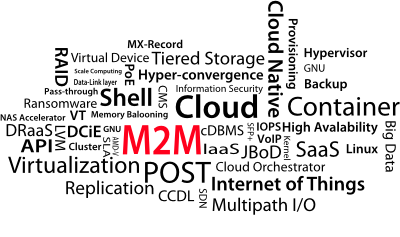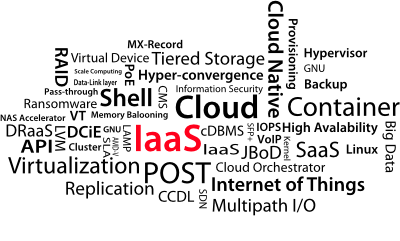- Details
-
Category: Word of the Day
-
Published: Thursday, 04 February 2016 08:30
-
Written by Guru Advisor
M2M è l'acronimo di Machine-to-Machine, etichetta utilizzata per descrivere tutte quelle tecnologie che permettono ai dispositivi collegati in rete di scambiare informazioni e effettuare operazioni senza l'intervento di esseri umani. Spesso viene utilizzato per indicare sistemi di monitoraggio remoto, automazione e robotica in generale.
M2M stands for Machine-to-Machine, a label used to describe those technologies that allows devices on a network to share information and perform operations without a human intervention. It's often used to define remote monitoring tools, automation and robotics in general
- Details
-
Category: Word of the Day
-
Published: Wednesday, 03 February 2016 08:30
-
Written by Guru Advisor
IoT is the acronym of Internet of Things, and this term defines a network where devices, sensors, objects, people and animals are equipped with a univocal ID and are capable of exchanging data through the Internet without needing a direct man-machine interaction. The idea was born from the convergence of wireless technologies and the availability of sensors and tools that are more and more small, evoluted and cheap.
- Details
-
Category: Word of the Day
-
Published: Tuesday, 02 February 2016 08:30
-
Written by Guru Advisor
API stands for Application Programming Interface and defines a set of procedures the developer has been made available to implement specific features and interact with certain software. The term API often also means a set of libraries for a certain programming language.
The goal of APIs is the ease the developers' jobs by making possible an easy access to the features of the software platform.
- Details
-
Category: Word of the Day
-
Published: Monday, 01 February 2016 08:30
-
Written by Guru Advisor
The term Shell is associated with the Operating System's interface that allows to access to the services of the system itself. Shells can be graphical (GUI - Graphical User Interface) or command line (CLI - Command Line Interface).
The Shell is the most external and visible part of the OS, the part which is directly available to the user.
Usually the term Shell defines the system interaction textual tool (CLI), which is often used in the Linux world and, in general, on server OSes.
- Details
-
Category: Word of the Day
-
Published: Friday, 29 January 2016 08:30
-
Written by Guru Advisor
IaaS is the acronym of Infrastructure as a Service and defines one of the three fundamental cloud computing models with SaaS and PaaS.
IaaS consists in providing the client with computational resources using Internet. Usually the infrastructure provided is virtualized and includes storing space, computing power and network connectivity.
This approach is very flexible and scalable to the client as the management of the whole infrastructure is a provider’s concern.
- Details
-
Category: Word of the Day
-
Published: Thursday, 28 January 2016 08:30
-
Written by Guru Advisor
SPF is the acronym for Small Form-Factor Pluggable which refers to a typology of optical connectors with hot-plug connections. SFP+, the evolute version of SFP (enhanced SFP), supports a bandwidth of 16Gbps and can be used to create 8GBps optical fibre connections, 10GBps Ethernet and Optical Transport Network with the OTU2 standard. SFP+ also saw the introduction of the support to Direct Attach which allows to link two SFP+ ports without dedicated transmitters.
SFP+ connectors are often found in higher tier products as it’s a widespread interface adopted by the main manufacturers of network devices.
- Details
-
Category: Word of the Day
-
Published: Wednesday, 27 January 2016 08:30
-
Written by Guru Advisor
An MX record (which stands for Mail Exchanger record) is a DNS record that points to the mail server that is authorized to accept emails belonging to the destination domain. The MX record also contains a priority index and specifies if several mail servers do exist for that domain.
- Details
-
Category: Word of the Day
-
Published: Tuesday, 26 January 2016 10:09
-
Written by Guru Advisor
An Hypervisor is a software that allows several operating systems to share a single physical host. It’s also called Virtual Machine Manager and manages the distribution of the computational resources between the installed virtual machines so that the behaviour of the single guest operating systems is completely transparent with respect of the underlying physical hardware.
There two kind of Hypervisors: type-1 -also called bare-metal- which are directly installed on the host (such as ESXi, Hyper-V, XenServer and Proxmox) and type-2, called hosted. In this case software is installed as an operating system level application (like VMware Player, VirtualBox, etc).
- Details
-
Category: Word of the Day
-
Published: Monday, 25 January 2016 08:13
-
Written by Guru Advisor
Memory Balooning is a memory management system that allows the physical host to use the RAM memory that is not being used by the hosted Virtual Machines. This technique allows to provide virtual machines with an overall RAM bigger that the actual installed memory leveraging the fact that no VM uses all the assigned memory.
- Details
-
Category: Word of the Day
-
Published: Friday, 22 January 2016 17:41
-
Written by Guru Advisor
Madware is a term that defines a software, often found in the mobile world, that gets installed on the device with the consent of the user when installing some free apps or clicking on ads popups. This term has been forged by Symantec and it’s a portmanteau between “mobile”a and “adware”.
- Details
-
Category: Word of the Day
-
Published: Friday, 22 January 2016 17:41
-
Written by Guru Advisor
Hybrid Cloud defines a cloud computing model where elements of a public Cloud and of a private Cloud are used together.
This solution is very flexible as it allows to distribute the workload between the two types of Cloud according to its entity, thus optimizing the usage of resources. For instance a private Cloud can be used to store the company’s data, while a public Cloud can be leveraged to analyse data and for those jobs that require a great computational power.
- Details
-
Category: Word of the Day
-
Published: Wednesday, 20 January 2016 17:34
-
Written by Guru Advisor
Disaster Recovery as a Service is a service provided to the client where a provider offers some kind of Disaster Recovery solution. Usually it consists in the remote replication of hosts (they can be either physical or virtual) in order to avoid a failover situation in case of a natural disaster or some damages by humans.
Intervention modalities are defined by means of a dedicated Service Level Agreement (SLA); DRaaS is best suited for small-medium companies that don’t have enough resources to build their own internal DR system.






































